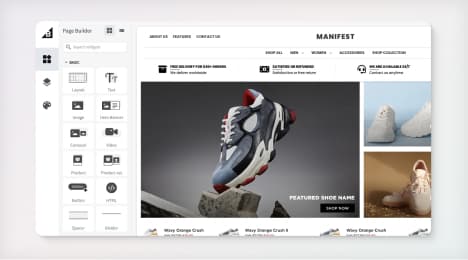
Watch Our Product Tour
See how BigCommerce helps you build and manage your online store with ease.
- Ecommerce Insights

6 Key Steps to Launch Your Online Store
Explore our Launch Foundations series to get your BigCommerce store up and running quickly.
BigCommerce helps growing businesses, enterprise brands, and everything in-between sell more online.
What is an advertising network?
An advertising network, or ad network, connects businesses that want to run advertisements with websites that wish to host them. The principle attribute of an ad network is the gathering of ad space and matching it with the advertiser's needs.
The term ad network is media neutral, but is often used to imply "online ad network" since the marketplace of aggregated publisher ad space and advertisers is increasingly found on the Internet. The crucial difference between traditional and online ad networks is that online ones deliver advertisements to the public through an ad server. Delivering ads through one central hub allows the business owner to use various methods of targeting, tracking and reporting that don't exist with traditional media alternatives.
How do they work?
Ad networks work with publishers all over the Web, helping anyone who has unsold inventory, or ad space, and wishes to monetize their offerings. The networks then aggregate this inventory, package it and sell it to advertisers (1).
Pros and cons
The benefits of using ad networks are numerous for both content providers and advertisers. Content providers find them an easy and reliable way to sell inventory, although the revenue is typically less than what they could earn selling the space themselves. Advertisers also like the ease of use. With minimal effort, they can purchase a campaign that targets a specific group of consumers on websites throughout the world. Ad networks are also known for flexible payment models and cost efficiencies.
The downside to advertisers is limited control over ad placements. The possibility exists that ads could appear next to inappropriate content. Many advertisers have also complained that their own campaign analytics often do not match up with the metrics provided by the networks (2). Despite these downfalls, many businesses find ad networks to be an affordable and efficient way of reaching consumers.
Pricing structure
Ad networks offer many different pricing models to suit the needs of different businesses.
CPM - cost-per-mille (Latin for "thousand") is the simplest of ad delivery options. Advertisers pay a price for every 1,000 impressions delivered. An ad served on someone's browser is an impression. Whether or not the user clicks on the ad has no bearing on the price.
CPC - cost-per-click is a performance-based model. Impressions served do not factor in cost. Instead, advertisers pay for every click they get on an ad campaign. This method of pricing often depends upon advertisers bidding on the maximum amount they will pay for a single click, a model that's become very popular on Google AdSense and Adwords. The downside of CPC is the uncertainty of how often the ad will be served, however, the low risk and focus on performance still make it an attractive option to most marketers.
CPA - cost-per-acquisition, or cost-per-action, takes the performance-based model even further by guaranteeing advertisers will only pay for a specific action or conversion by the user. This ad delivery metric is often a key performance indicator for marketers when evaluating return on investment (ROI). A campaign that cost $250 and resulted in 25 sales means the CPA was $10. If the per-sale-profit exceeds $10 then the campaign was a success.
Ad targeting capabilities
Targeting capabilities for advertisers have increased dramatically over the years due to massive quantities of consumer data that have become available to the marketing community. Targeting capabilities may include:
Age
Gender
Income
Geography
Behavior - displays relevant ads to users based on content they've clicked on while visiting several sites.
Google Display Network (GDN)
Google has a vast network of websites advertisers can display ads on, from the New York Times down to the smallest blogs on the Web. They offer several options businesses can use to target audiences. They may even combine two or more targeting methods in the same campaign (3).
Contextual Targeting - Google delivers advertisements to users based on the content they consume. The content aggregator - Google, in this case - assigns labels to specific websites and matches it with keywords associated with a specific ad. GDN can also serve an ad that contextually fits websites where a user has previously been. For instance, a user might visit an outdoor sporting goods website and then click away to look at political news site. Contextual targeting could be used to show an ad for family-sized camping tents to that user on the political site.
Placement Targeting - marketers can choose which websites or webpages the ad serves on.
Remarketing - users who visit a website are then shown advertisements for that website as they browse other areas of the display network. Remarketing can be a highly effective tactic to market to people who may have abandoned their shopping carts on your website. To increase the chance of a sale, you should combine this with an abandoned cart email.
Interest Categories - Marketers can target people based on interests they reveal in the Web content they visit.
Topic Targeting - Similar to interest categories, topic targeting allows marketers to pick a specific topic and Google will display the ads on quality sites related to that subject.
Geographic and Language - Marketers can distribute their ads within a specified region or postal code and define the native language of the audience.
Demographic Targeting - Ads are distributed to an audience based on age and gender.
The growth of advertising networks, and the wealth of user data that has come with it, presents tremendous opportunities for marketers who want to expand their reach with consumers. Whether your goals are to build awareness or generate conversions, an advertising network can help you find your audience and get results.
BigCommerce helps growing businesses, enterprise brands, and everything in-between sell more online.
Start growing your ecommerce business even faster.
High-volume or established business? Request a demo